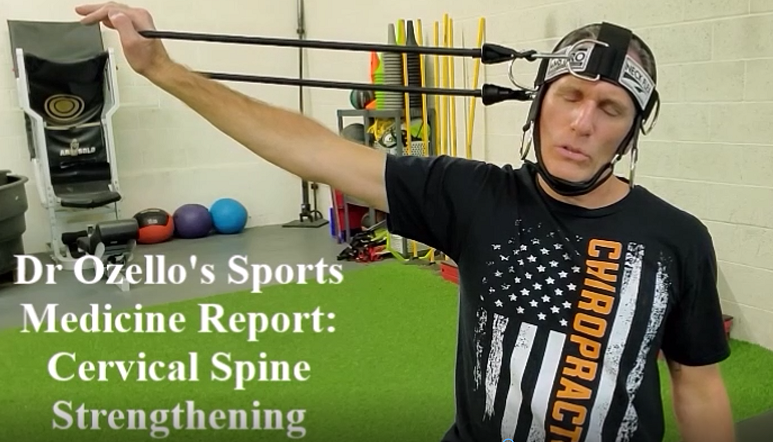Build lifelong neck health with exercise and proper positioning. Neck strength, flexibility, stamina and motion are vital for proper upper body posture and motion.
Neck pain is performance limiting and troublesome at every age and profession. Serious neck injuries have the potential to be debilitating and career ending for athletes and non-athletes.
Anatomy: In medical terminology the neck is named the cervical spine. The neck contains seven articulating vertebra.
Intervertebral discs (IVD) occupy the space between all the cervical vertebra except between the skull and the first vertebra and between the first vertebra and the second cervical vertebra. Intervertebral discs possess a hard outer lining and a gel-like nucleus. The intervertebral disc functions to distribute shock throughout the vertebra.
Direct blood flow to the intervertebral disc stops around the age of six. Following the cessation of direct blood flow, the disc receives its nutrients through osmosis from the vertebrae located directly above and below it.
Neck muscles connect the cervical vertebrae, sternum, collar bones and shoulder blades to the skull. They function to move and support the head. Tendons are strong bands of fibrous connective tissue that attach the muscles to bones. Tough structures called ligaments attach bones to each other to provide support and stability to joints.
The spinal cord travels vertically through the spinal column. Spinal nerve roots branch off the spinal cord in between each vertebra. Branches of cervical nerve roots transmit signals to the neck, shoulders and upper extremities. Impingement on a spinal nerve root in the cervical spine may lead to symptoms throughout the entire course of the nerve. Many severe neck injuries involve the intervertebral disc placing pressure on the spinal nerve roots.
Neck pain sources: Multiple extrinsic sources of neck pain exist, ranging from trauma to repetitive strain. Correct body positioning, posture, flexibility and strength are vital to neck health. Incorrect work station ergonomics combined with static positioning and repetitive motions create muscle tightness, strength imbalances and symptoms.
Motion: The human body is designed for motion. Unfortunately, spending long hours at the computer work station is a way of life for millions of Americans. Combat static seated positioning and repetitive keyboarding motions with frequent breaks and dynamic motion exercises.
Motion is a catalyst for neck health. Prevent and manage repetitive strain injuries with movement. Take micro-breaks to correct your body positioning and posture. Move your neck, shoulders and upper extremities during regularly scheduled short breaks to reduce muscle tension. Take a reprise from sitting every hour by getting up and walking for a minute or two.
Ergonomics: Proper computer work station ergonomics is essential to neck health. The top of your computer work station should be at eye level or slightly below eye level.
Maintain a posture where your shoulders are not rolled forward and your neck is not protracted forward. Sit up straight so an imaginary vertical line runs through your shoulder and ears.
Relax your shoulders downward. Never hold your shoulders in a shrugged position and never hold a phone between your ears and shoulder.
Proper lifting technique: Utilize proper lifting technique to prevent injury. Position your legs close to the object. Squat down, never bend forward. Grasp the object from underneath. Keep your spine straight and hold your neck in line with your spine. Look straight forward, not upward or downward while lifting. Never bend, twist or lower your head when lifting.
Sports: Neck strength is vital to sports success. Neck pain from sports is extremely common. The origin of neck pain may be a violent twist of the neck or spine. Examples include wrestling and swinging a golf club. Collisions in contact sports like football and lacrosse lead to neck pain. Compression of the neck is another source of sports related neck pain.
Exercise: Increase neck strength and flexibility to improve performance and lessen injury risk.
Strength: Basic neck strengthening exercises can be performed with or without equipment. A simple method is to apply light resistance with your hand. Push against your hand and move your neck through a pain-free range of motion. Work your neck in every direction to strengthen the entire neck.
Execute neck strengthening exercises in the following directions. Bending the head forward, bending the head backward, retracting the head straight backwards, bending to the left side, bending to the right side, rotating to the left side and rotating to the right side.
Work through a pain-free range of motion while standing or sitting in proper posture. If an exercise elicits symptoms forgo that exercise and proceed to another.
Resistance training for the upper back and shoulders strengthens the neck. Weight training exercises such as shrugs, cleans and kettlebell swings increase neck strength and endurance.
Stretching: Stretching increases muscle flexibility, improves joint range of motion and decreases muscles tightness. The effectiveness of stretching is increased when the muscles are warmed-up. Neck stretching is best performed in a hot shower or after exercise.
Stretching is not a flexibility contest and should never elicit symptoms. Move gradually into a mild comfortable stretch. Hold a gentle neck stretch between ten to twenty seconds. Stretch your neck forward, to both sides and between straight forward and directly to the side.
Build and preserve lifelong neck health with consistent and correct strengthening and stretching procedures. Avoid bothersome neck conditions by employing proper ergonomics, dynamic motions, proper lifting technique, sound nutrition practices, proven supplementation strategies and consistent chiropractic treatments. Develop neck health to live a healthier, fitter, more functional life.
Dr Donald A Ozello DC of Championship Chiropractic in Las Vegas, NV
Web Site: http://www.championshipchiropractic.com/
Blog: https://www.championshipchiropractic.com/wordpress/
YouTube: https://www.youtube.com/user/drdozellodc/videos
Twitter: https://twitter.com/drdozellodc
Facebook: https://www.facebook.com/Championship-Chiropractic-280141628688300/
LinkedIn: https://www.linkedin.com/in/dr-donald-a-ozello-dc-716b3233
“Running: Maximize Performance & Minimize Injuries” https://www.amazon.com/Running-Performance-Chiropractors-Minimizing-Potential/dp/1493618741
**Disclaimer: Always consult a medical professional before beginning an exercise program. Always work within your capabilities. Never perform an exercise that elicits or increases pain or symptoms. Reading this article and viewing the linked videos does not take the place of seeing a medical professional. Please visit a medical professional for evaluation, diagnosis & treatment.

